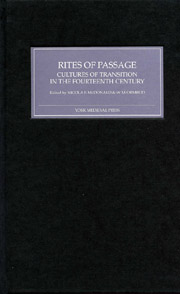Book contents
- Frontmatter
- Contents
- List of Contributors
- Preface
- Introduction: Rites of Passage
- Re-writing a Rite of Passage: The Peculiar Funeral of Edward II
- Coming to Kingship: Boy Kings and the Passage to Power in Fourteenth-Century England
- Boy/Man into Clerk/Priest: The Making of the Late Medieval Clergy
- Manners Maketh Man: Living, Dining and Becoming a Man in the Later Middle Ages
- Rites of Passage in French and English Romances
- Becoming Woman in Chaucer: ‘On ne naît pas femme, on le meurt’
- John Gower's Fear of Flying: Transitional Masculinities in the Confessio Amantis
- ‘Le moment de conclure’: Initiation as Retrospection in Froissart's Dits amoureux
- Index
- YORK MEDIEVAL PRESS: PUBLICATIONS
Rites of Passage in French and English Romances
Published online by Cambridge University Press: 12 September 2012
- Frontmatter
- Contents
- List of Contributors
- Preface
- Introduction: Rites of Passage
- Re-writing a Rite of Passage: The Peculiar Funeral of Edward II
- Coming to Kingship: Boy Kings and the Passage to Power in Fourteenth-Century England
- Boy/Man into Clerk/Priest: The Making of the Late Medieval Clergy
- Manners Maketh Man: Living, Dining and Becoming a Man in the Later Middle Ages
- Rites of Passage in French and English Romances
- Becoming Woman in Chaucer: ‘On ne naît pas femme, on le meurt’
- John Gower's Fear of Flying: Transitional Masculinities in the Confessio Amantis
- ‘Le moment de conclure’: Initiation as Retrospection in Froissart's Dits amoureux
- Index
- YORK MEDIEVAL PRESS: PUBLICATIONS
Summary
Many romances are concerned with the processes of growing up, and contain references to real-life ‘rites of passage’ for medieval boys and men, particularly of the landowning class, and also fictional and fantastic variants on these. Others trace a hero's progress through formative experiences of lonely testing, hardship or humiliation, which have affinities with rites of passage, experiences through which the hero is changed, matured and ends in more satisfactory, even triumphant, conformity with the ideals of upper-class masculine adult identity. This paper examines all three categories: historically accurate rites; fictional or fantastic variants; and times of trial. Other themes often accompanying this focus on youthful development and times of trial include families lost and found, the hero's eventual creation of a new family and – especially – exploration of the nature of true knighthood and of how far lineage or nurture create a knight. Kennedy points to an ‘identity theme’: a hero discovers who he is, gains a name (sometimes literally) through prowess or reclaims lost reputations. Love is often involved in romances' rites of passage: the hero's wedding frequently forms part of his career's triumphant finale; initiation into heterosexual love may represent perilous testing or another step towards knightly identity; some romances represent youths as learning to negotiate competition between the claims of the male and female spheres. Rites of passage are inevitably prominent in romances and are the focus for both celebration and problematization of medieval chivalry and masculinity.
- Type
- Chapter
- Information
- Rites of PassageCultures of Transition in the Fourteenth Century, pp. 83 - 108Publisher: Boydell & BrewerPrint publication year: 2004



